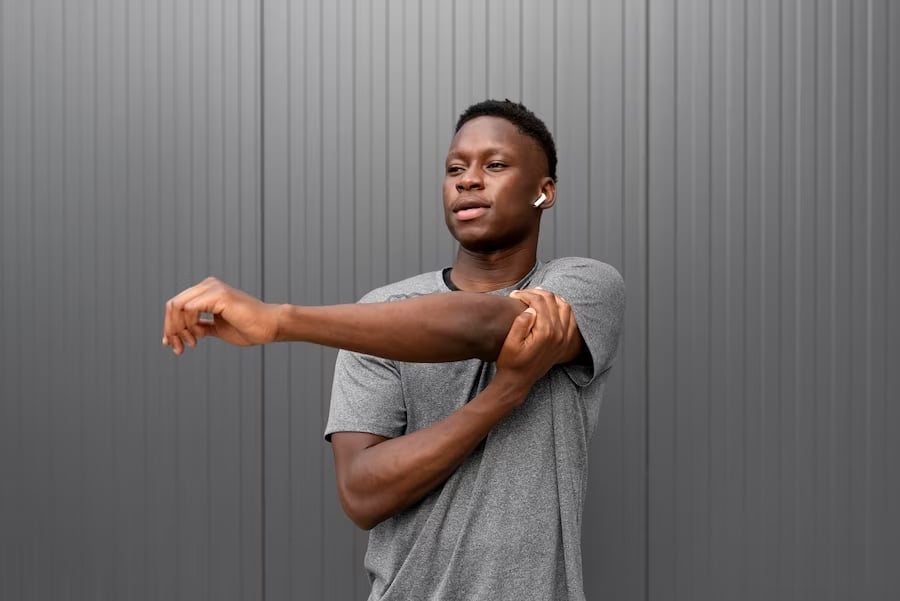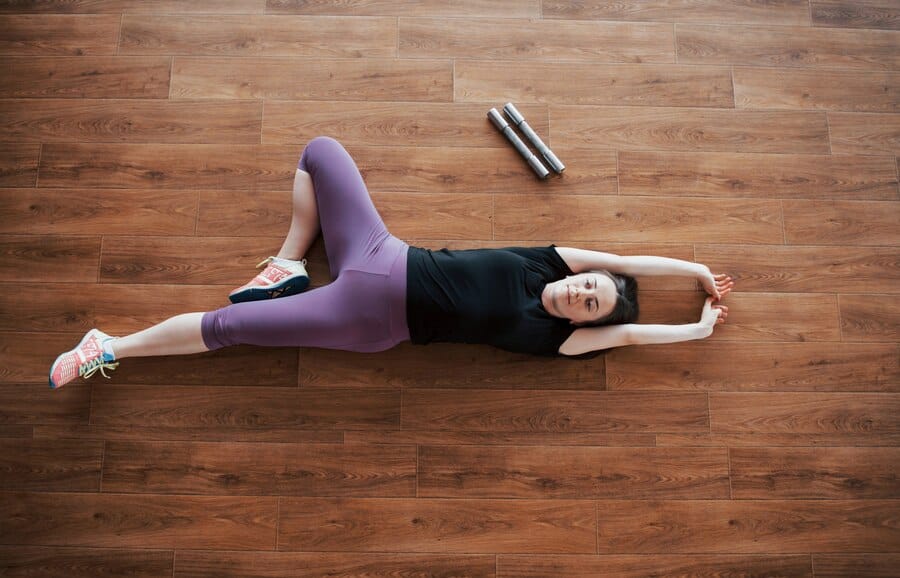If you experience pain and stiffness in your shoulder, you may suffer from shoulder bursitis.
It’s no secret that something as common as a swollen bursa can really put a damper on your day-to-day duties, but the good news is that – with the right exercises – shoulder bursitis doesn’t have to slow you down.
So, if you’re feeling like you’ve been hit with the dreaded ‘shoulder bursitis bug,’ don’t despair.
Read on for advice on efficient exercises that reduce inflammation, restore range of motion, and prevent the recurrence of this pesky condition.
Best Exercises & Workouts For Shoulder Bursitis
Let’s take a look at the low-impact workouts for shoulder bursitis relief:
1. Posterior Shoulder Stretch
The posterior shoulder stretch has to be on your list of best workouts for shoulder bursitis as it targets the muscles in the back of the shoulder, including the infraspinatus and teres minor. It helps to improve flexibility, reduce tension, and promote better shoulder mobility.
Step-By-Step Guide
- Stand with your feet shoulder-width apart and your knees slightly bent.
- Bring your right arm across your chest horizontally, keeping it straight or with a slight bend at the elbow.
- Use your left hand to gently pull your right arm closer to your chest until you feel a stretch in the back of your right shoulder.
- Keep your shoulders relaxed and avoid hunching or leaning to either side.
- Hold the stretch for 15-30 seconds, breathing deeply and maintaining a comfortable stretch.
- Slowly release the tension and switch sides, repeating the stretch with your left arm.
2. Shoulder Lift
The shoulder lift exercise helps strengthen the upper trapezius and other shoulder-stabilizing muscles.
This increased muscle strength can provide more support to the shoulder joint, potentially reducing the strain on the affected bursa.
Step-By-Step Guide
- Sit or stand with your back straight and your shoulders relaxed.
- Slowly lift both shoulders toward your ears without shrugging or tensing your neck.
- Hold the raised position for 2-3 seconds, feeling the contraction in your upper trapezius muscles.
- Gently lower your shoulders back down to the starting position.
- Repeat this movement for 10-15 repetitions, focusing on controlled and smooth movements.
3. Shoulder Rotation Stretch
The supraspinatus, infraspinatus, teres minor, and subscapularis are the rotator cuff muscles targeted by this effective shoulder bursitis exercise.
These muscles can be stretched to help with shoulder flexibility and ease shoulder bursitis pain.
Step-By-Step Guide
- Stand with your feet shoulder-width apart and your knees slightly bent.
- Place your right arm straight out to the side at shoulder level, with your palm facing down.
- Slowly rotate your right arm inward, so your hand moves toward the front of your body.
- Continue the rotation until you feel a gentle stretch in your shoulder and chest. Avoid any pain.
- Hold the stretch for 15-30 seconds, focusing on relaxing your muscles.
- Return your arm to the starting position and repeat the stretch with your left arm.
4. Overhead Stretch
The overhead stretch helps improve the shoulder joint’s flexibility, particularly the deltoid and shoulder girdle muscles.
This can potentially ease the symptoms of shoulder bursitis and enhance the range of motion in the shoulder.
Step-By-Step Guide
- Stand or sit with your back straight and shoulders relaxed.
- Interlace your fingers and extend both arms overhead, palms facing upwards.
- As you reach up, lengthen your spine and engage your core to avoid arching your back.
- Hold the stretch for 15-30 seconds, keeping your shoulders away from your ears.
- Focus on breathing deeply and expanding your ribcage during the stretch.
5. Up-the-back Stretch
Are you wondering, “Will shoulder bursitis go away with exercises?” If so, the up-the-back stretch has to be your best bet as it targets the triceps and rear shoulder muscles, such as the infraspinatus and teres minor.
Stretching these muscles can help alleviate tension and promote flexibility in the shoulder area.
Step-By-Step Guide
- Reach your right arm over your right shoulder and down your upper back.
- Bend your right elbow and let your right-hand point downwards, reaching towards the space between your shoulder blades.
- Bring your left hand behind your back and try to reach for your right fingertips. Use a towel or strap to bridge the gap between your hands if you cannot reach.
- Gently pull your right arm upwards with your left hand, deepening the stretch without causing pain.
- Hold the stretch for 15-30 seconds, breathing calmly and maintaining proper posture.
- Release the stretch slowly and switch sides, repeating the exercise on your left arm.
6. Shoulder Flexion Stretch
The deltoid and pectoralis major are two of the muscles worked on in a shoulder flexion stretch. The pain associated with shoulder bursitis may be alleviated by performing this stretch, which increases shoulder mobility.
Step-By-Step Guide
- Stand with your feet shoulder-width apart and your knees slightly bent.
- Raise your right arm forward and upward, reaching towards the ceiling.
- Keep your arm straight or with a slight bend at the elbow, avoiding any forceful movement.
- Engage your core and maintain good posture throughout the stretch.
- Hold the stretch for 15-30 seconds, feeling the gentle elongation in the front of your right shoulder.
- Lower your arm slowly and repeat the stretch with your left arm.
Over To You
Shoulder bursitis can limit your activity and daily life in many ways, but by following the shoulder bursitis exercises in this blog post, you’re well on your way to taking control of your shoulder pain.
Now you can be like Clint Eastwood when he faces off with a villain in one of his Westerns – confident, strong, and able-bodied.
Plus, there’s nothing quite like a peaceful morning stretching session or physical therapy session to help make your day better.
There is no magic cure for bursitis, but there are tools and resources to help reduce discomfort and keep it from taking over your life.
FAQs
Should I rest or exercise with bursitis in my shoulder?
It is advisable to prioritize rest over exercise when dealing with shoulder bursitis. Rest helps reduce inflammation and allows the affected area to heal. Avoid activities that aggravate the pain and seek medical advice for appropriate treatment and recovery plans. However, the exercises discussed in this blog post are safe.
What exercises should I avoid with shoulder bursitis?
With shoulder bursitis, it is crucial to avoid exercises that put excessive strain on the shoulder joint. High-impact activities, heavy weightlifting, and repetitive overhead movements should be avoided. Instead, focus on gentle stretching and low-impact exercises recommended by a healthcare professional.
Does physiotherapy help shoulder bursitis?
Yes, physiotherapy can be beneficial for managing shoulder bursitis. A qualified physiotherapist can design a tailored treatment plan to improve shoulder strength, flexibility, and mobility. Therapeutic exercises and manual techniques can aid in reducing pain, promoting healing, and preventing future injuries.











